 W
WThe Workers Circle or Der Arbeter Ring, formerly the Workmen's Circle, is an American Jewish nonprofit organization that promotes social and economic justice, Jewish community and education, including Yiddish studies, and Ashkenazic culture. It operates schools and Yiddish education programs, and year-round programs of concerts, lectures and secular holiday celebrations. The organization has community branch offices throughout North America, a national headquarters in New York City and approximately 11,000 members nationwide. It owns and operates a summer camp located in Hopewell Junction, New York called Camp Kinder Ring. It also runs an adult vacation campground facility, Circle Lodge, with bungalows and cottages, and a healthcare center in Bronx, New York.
 W
WA Baal Shem was a historical Jewish practitioner of Practical Kabbalah and supposed miracle worker. Employing the names of God, angels, Satan and other spirits, Baal Shem are claimed to heal, enact miracles, perform exorcisms, treat various health issues, curb epidemics, protect people from disaster due to fire, robbery or the evil eye, foresee the future, decipher dreams, and bless those who sought his powers.
 W
W"Bei Mir Bistu Shein" is a popular Yiddish song written by Jacob Jacobs (lyricist) and Sholom Secunda (composer) for a 1932 Yiddish language comedy musical, I Would If I Could, which closed after one season. The score for the song transcribed the Yiddish title as "Bay Mir Bistu Sheyn". The original Yiddish version of the song is a dialogue between two lovers. Five years after its 1932 composition, the song became a worldwide hit when recorded under a Germanized title as "Bei mir bist du schön" by The Andrews Sisters in November 1937.
 W
WThe Birobidzhaner Shtern is a newspaper published in both Yiddish and Russian in the Jewish Autonomous Oblast of Russia. It was set up in November 1930 in Birobidzhan to cater for the newly arrived Jewish immigrants. It is the oldest national newspaper in the region.
 W
WA blech is a metal sheet used by many observant Jews to cover stovetop burners on Shabbat, as part of the precautions taken to avoid violating the halachic prohibition against cooking on the Sabbath.
 W
WCholent or hamin is a traditional Jewish stew. It is usually simmered overnight for 12 hours or more, and eaten for lunch on Shabbat. Cholent was developed over the centuries to conform with Jewish laws that prohibit cooking on the Sabbath. The pot is brought to a boil on Friday before the Sabbath begins, and kept on a blech or hotplate, or left in a slow oven or electric slow cooker, until the following day. Cholent originated in ancient Judea, possibly as far back as the Second Temple period, and over the centuries various Jewish diaspora communities created their own variations of the dish.
 W
WA dreidel or dreidle is a four-sided spinning top, played during the Jewish holiday of Hanukkah.
 W
WIn Jewish mythology, a dybbuk is a malicious possessing spirit believed to be the dislocated soul of a dead person. It supposedly leaves the host body once it has accomplished its goal, sometimes after being exorcised.
 W
WEyerlekh are creamy, flavorful unhatched eggs found inside just-slaughtered chickens and typically cooked in soup. They were historically common in Ashkenazi Jewish cuisine, but their usage has become much less frequent with the rise of prepackaged chicken parts.
 W
WA farbrengen is a Hasidic gathering. This term is only used by Chabad-Lubavitch Hasidim, as other Hasidim have a tish or a botteh. It may consist of explanations of general Torah subjects, with an emphasis on Hasidic philosophy, relating of Hasidic stories, and lively Hasidic melodies, with refreshments being served. It is regarded as a time of great holiness. Farbrengens are public events open to non-Hasidim as well.
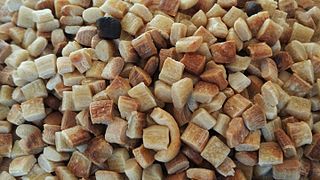 W
WFarfel is small pellet- or flake-shaped pasta used in Ashkenazi Jewish cuisine. It is made from an egg noodle dough and is frequently toasted before being cooked. It can be served in soups or as a side dish. In the United States, it can also be found pre-packaged as egg barley.
 W
WA firzogerin,, alternately vorsangerin, foreleiner, zugerin, or zugerke, was a historic role in the synagogue for a learned Jewish woman leading women in prayer from the weibershul as a precentress, parallel to the main service led by a male chazzan.
 W
WFrum is a word that describes Jewish religious devotion. The appellation is generally, but not only, applied to certain movements within Ashkenazic Orthodox Judaism, and used by some members of these groups as a self-reference.
 W
WGefilte fish is a dish made from a poached mixture of ground deboned fish, such as carp, whitefish, or pike. It is traditionally served as an appetizer by Ashkenazi Jewish households. Historically it consisted of a minced-fish forcemeat stuffed inside the intact fish skin. By the 16th century, cooks had started omitting the labor-intensive stuffing step, and the seasoned fish is most commonly formed into patties similar to quenelles or fish balls. These are popular on Shabbat and Jewish holidays such as Passover, although they may be consumed throughout the year.
 W
WIn modern Hebrew and Yiddish goy is a term for a gentile, a non-Jew. Through Yiddish, the word has been adopted into English also to mean gentile, sometimes with a pejorative sense.
 W
WIn Ashkenazi Jewish cuisine, gribenes or grieven are crisp chicken or goose skin cracklings with fried onions. As with other cracklings, gribenes are a byproduct of rendering animal fat to produce cooking fat, in this case kosher schmaltz.
 W
WA hamantash is an Ashkenazi Jewish triangular filled-pocket cookie, usually associated with the Jewish holiday of Purim. The name refers to Haman, the villain in the Purim story. In Hebrew, hamantashen are known as אוזני המן meaning 'Haman's ears'.
 W
WHanukkah gelt, also known as gelt, refers to money given as presents during the Jewish festival of Hanukkah. It is typically given to children and sometimes teachers, often in conjunction with the game of Dreidel. In the 20th century, candy manufacturers started selling Hanukkah-themed chocolate coins wrapped in gold or silver foil, as a substitute or supplement to real money gifts.
 W
WThere are several Jewish and Hebrew greetings, farewells, and phrases that are used in Judaism, and in Jewish and Hebrew-speaking communities around the world. Even outside Israel, Hebrew is an important part of Jewish life. Many Jews, even if they do not speak Hebrew fluently, will know several of these greetings.
 W
WA kittel is a white linen or cotton robe worn by religious Jews on holidays, in the synagogue or at home when leading the Passover seder. Kittels are sometimes worn by grooms. It is also customary for Jews to be buried in a kittel.
 W
WKreplach are small dumplings filled with ground meat, mashed potatoes or another filling, usually boiled and served in chicken soup, though they may also be served fried. They are similar to Polish and Ukrainian uszka, Russian pelmeni, Italian ravioli or tortellini, German Maultaschen, and Chinese jiaozi and wonton. The dough is traditionally made of flour, water and eggs, kneaded and rolled out thin. Some modern-day cooks use frozen dough sheets or wonton wrappers. Ready-made kreplach are also sold in the kosher freezer section of supermarkets.
 W
WKugel is a baked pudding or casserole, most commonly made from egg noodles or potato. It is a traditional Ashkenazi Jewish dish, often served on Shabbat and Jewish holidays.
 W
WKvitel refers to a practice developed by Hasidic Judaism in which a Hasid writes a note with a petitionary prayer and gives it to a Rebbe in order to receive the latter's blessing. This prayer may be a general request for health, livelihood, or success, or a specific request such as recovery from illness, the ability to bear children, a wedding match, etc.
 W
WA landsmanshaft is a mutual aid society, benefit society, or hometown society of Jewish immigrants from the same European town or region.
 W
WA latke, is a type of potato pancake or fritter in Ashkenazi Jewish cuisine that is traditionally prepared to celebrate Hanukkah. Latkes can be made with ingredients other than potatoes including cheese and zucchini.
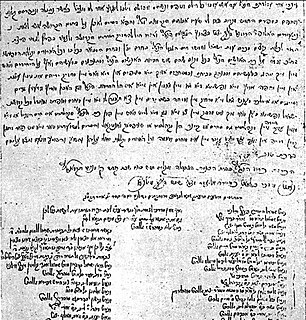 W
WMisnagdim was a religious movement among the Jews of Eastern Europe which resisted the rise of Hasidism in the 18th and 19th centuries. The Misnagdim were particularly concentrated in Lithuania, where Vilnius served as the bastion of the movement, but anti-Hasidic activity was undertaken by the establishment in many locales. The most severe clashes between the factions took place in the latter third of the 18th century; the failure to contain Hasidism led the Misnagdim to develop distinct religious philosophies and communal institutions, which were not merely a perpetuation of the old status quo but often innovative. The most notable results of these efforts, pioneered by Chaim of Volozhin and continued by his disciples, were the modern, independent yeshiva and the Musar movement. Since the late 19th century, tensions with the Hasidim largely subsided, and the heirs of Misnagdim adopted the epithet Litvishe or Litvaks.
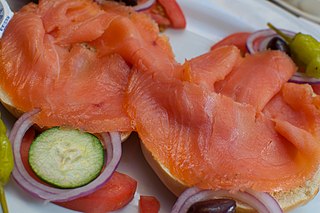 W
WLox is a fillet of brined salmon. Lox is frequently served on a bagel with cream cheese, and often garnished with tomato, sliced onion, cucumbers, and capers.
 W
WMatzah brei, sometimes spelled matzah brie, matzoh brei, or matzo brei, is a dish of Ashkenazi Jewish origin made from matzah fried with eggs. It is commonly eaten as a breakfast food during the Jewish holiday of Passover.
 W
W"Mazel tov" or "mazal tov" is a Jewish phrase used to express congratulations for a happy and significant occasion or event.
 W
WA Memorbuch is a book dedicated to the memory of martyrs in the Ashkenazi world.
 W
WMokum (מקום) is the Yiddish word for "place" or "safe haven". It is similar to the Hebrew word makom, from which it is derived.
 W
WOy vey is a Yiddish phrase expressing dismay or exasperation. Also spelled oy vay, oy veh, or oi vey, and often abbreviated to oy, the expression may be translated as, "oh, woe!" or "woe is me!" Its Hebrew equivalent is oy vavoy.
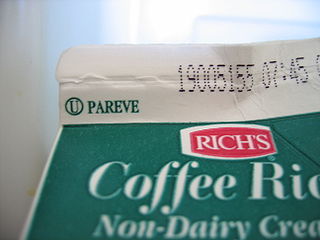 W
WIn kashrut, the dietary laws of Judaism, pareve is a classification of edible substances that contain neither dairy nor meat ingredients. Food in this category includes all items that grow from the ground, fish, eggs, and non-biological edible items. Kashrut forbids consuming mixtures of milk and meat, consuming milk and meat at the same meal, consuming dairy foods within a period of time after consuming meat, and using the same dishes for both dairy and meat. Pareve foods, being neutral, can be consumed with either dairy or meat.
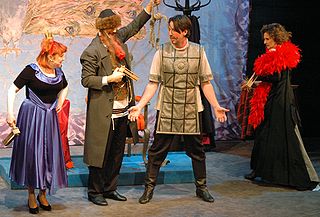 W
WA Purim spiel or Purim play is an ensemble of festive practices for Purim. It is usually a comic dramatization of the Book of Esther, the central text and narrative that describes what transpired on Purim and why it is celebrated as an important Jewish holiday.
 W
WA Rebbe or Admor is the spiritual leader in the Hasidic movement, and the personalities of its dynasties. The titles of Rebbe and Admor, which used to be a general honor title even before the beginning of the movement, became, over time, almost exclusively identified with its Tzaddikim.
 W
WKhal Adas Yisroel, usually referred to as the Schiff Shul, was the main Orthodox synagogue in Vienna prior to the Holocaust. The synagogue no longer exists since it was destroyed by the Nazis on Kristallnacht. A building that was adjacent to the Schiffshul and was part of its complex remains.
 W
WSchnorrer is a Yiddish term meaning "beggar" or "sponger". The word Schnorrer originally occurred in the German language to describe a freeloader who frequently asks for little things, like cigarettes or little sums of money, without offering a return.
 W
WShas Pollak were Jewish mnemonists who, according to the 1917 report of George Stratton in the Psychological Review, memorized the exact layout of words in more than 5,000 pages of the 12 books of the standard edition of the Babylonian Talmud. Stratton's report consists of accounts of and comments on testimonials of three eyewitnesses. Two of the eyewitnesses stated that the memorizing was related to the Talmud part, printed in the centers of the pages, and not the surrounding commentary.
 W
WSheitel is a wig or half-wig worn by some Orthodox Jewish married women in order to obey with the requirement of Jewish law to cover their hair. Some Hasidic groups encourage sheitels, while others avoid them.
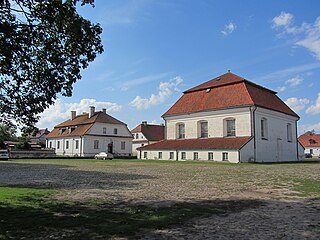 W
WA shtetl or a shtetel was a small town with a large Jewish population which existed in Central and Eastern Europe before the Holocaust. Shtetls were mainly found in the areas that constituted the 19th century Pale of Settlement in the Russian Empire as well as in Congress Poland, Austrian Galicia, Romania and Hungary.
 W
WA shtiebel is a place used for communal Jewish prayer. In contrast to a formal synagogue, a shtiebel is far smaller and approached more casually. It is typically as small as a room in a private home or a place of business which is set aside for the express purpose of prayer, or it may be as large as a small-sized synagogue. It may or may not offer the communal services of a synagogue.
 W
WA tchotchke is a small bric-à-brac or miscellaneous item. The word has long been used by Jewish-Americans and in the regional speech of New York City and elsewhere. It is Yiddish in origin.
 W
WTichel, also called a mitpachat, is the Yiddish word for the headscarf worn by many married Orthodox Jewish women in compliance with the code of modesty known as tzniut, which requires married women to cover their hair. Tichels can range from a simple plain color cotton kerchief tied in the back to elaborate head coverings using multiple fabrics and tying techniques.
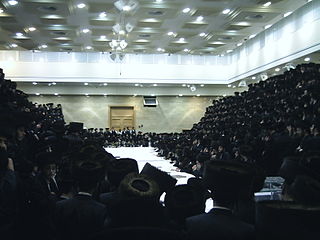 W
WA tische is a Shabbat or holidays gathering for Hasidic Jews around their Rabbi or "Rebbe". In Chabad, a tische is called hitveadut. It may consist of speeches on Torah subjects, singing of melodies known as niggunim and zemirot ("hymns"), with refreshments being served. Hasidim see it as a moment of great holiness. They are public events that are open to non-Hasidim as well.
 W
WTzimmes, tsimmes is a traditional Ashkenazi Jewish stew typically made from carrots and dried fruits such as prunes or raisins, often combined with other root vegetables.
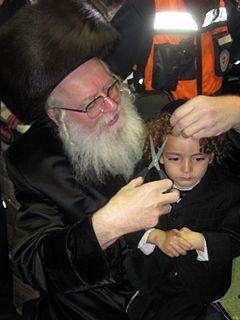 W
WUpsherin, Upsheren, Opsherin or Upsherinish is a haircutting ceremony observed by a wide cross-section of Jews and is particularly popular in Haredi Jewish communities. It is typically held when a boy turns three years old. Among those who practice the upsherin, the male infant does not have his hair cut until this ceremony.